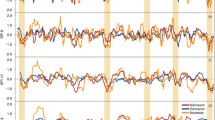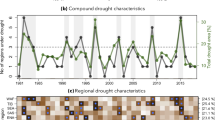Abstract
The physical mechanisms and potential predictability of North American drought on decadal timescales are reviewed in a simple and straightforward manner amenable to a wide audience. During decadal droughts, the tropical oceans, most notably cold states of the Pacific but also warm states of the Atlantic, provide forcing that continually nudges the atmosphere toward circulation anomalies that favor high pressure over southern North America and dry conditions. However, even in these regions, and even more so in the northwest and northeast, the oceans exert less than dominant control and actual drought onset, evolution and termination can deviate due, presumably, to potent internal atmosphere variability. The ocean influence, however, justifies efforts to determine if the driving sea surface temperature anomalies in the tropical Pacific and Atlantic are predictable beyond the seasonal to interannual timescale. Evidence to date, based on initialized predictions with coupled models, is tantalizingly suggestive that useful predictability on these timescales may exist within the atmosphere-ocean system although relevance to North American decadal drought has not yet been demonstrated. These recent advances in drought science and prediction warrant continued research aimed at developing useful long term predictions of drought that can guide adaptation and minimize the associated widespread social and economic disruptions.



Similar content being viewed by others
Notes
Sixteen member ensembles with later versions of the NCAR model up to the current CAM5.3 have been generated at Lamont. These models show similar behavior to CCM3 but the older model is chosen here due to a modestly better agreement between observations and model for precipitation history of the southwest. The observed precipitation values occasionally lie outside the two standard deviation spread of the model ensemble which could be because the 16 members are insufficient to capture the full range of model internal variability.
Cook et al. [10] show calibration and verification statistics for the NADA revealing quite uniform skill across North America despite variations in density of tree ring records.
References
Boer GJ. Long timescale potential predictability in an ensemble of coupled climate models. Clim Dyn. 2004;23:29–4.
Cane MA, Clement AC, Murphy LN, Bellomo K. Low pass filtering, heat flux and Atlantic multidecadal variability. J Clim. Submitted. 2017.
Cane MA, Zebiak SE, Dolan SC. Experimental forecasts of El Niño. Nature 1986;321:827–32.
Cayan D, Das T, Pierce D, Barnett T, Tyree M, Gershunova A. Future dryness in the southwest United States and the hydrology of the early 21st Century drought. Proc Nat Acad Sci. 2010;107:21271–6.
Chen X, Wallace JM. ENSO-like variability:1900-2013. J Clim 2017;28:9623–41.
Clement AC, Bellomo K, Murphy LN, Cane MA, Mauritsen T, Radel G, Stevens B. The Atlantic Multidecadal Oscillation without a role for ocean circulation. Science 2017;350:320–4.
Collins M, et al. Interannual to decadal climate predictability in the North Atlantic: a multimodel-ensemble study. J Clim. 2006;19:1195–1203.
Compo G, et al. The twentieth century reanalysis project. Quart J Roy Meteor Soc. 2011;137:1–28.
Cook B, Smerdon JE, Seager R, Cook ER. Pan-continental droughts in North America over the last millennium. J Clim. 2014;27:383–97.
Cook ER, Seager R, Heim RR, Vose RS, Herweijer C, Woodhouse C. Megadroughts in North America: placing IPCC projections of hydroclimatic change in a long term paleoclimatic context. J Quat Sci. 2010;25:48–61.
Delworth T, Manabe S, Stouffer R. Interdecadal variations of the thermohaline circulation in a coupled ocean-atmosphere model. J Clim. 1993;6:1993–2011.
Delworth T, Zeng F, Rosati A, Vecchi GA, Wittenberg AT. A link between the hiatus in global warming and North American drought. J Clim. 2017;28:3834–45.
Ding H, Greatbatch RJ, Latif M, Park W, Gerdes R. Hindcast of the 1976/77 and 1998/99 climate shifts in the Pacific. J Clim. 2013;26(19):7650–61.
Dunstone NJ, Smith DM. Impact of atmosphere and subsurface ocean data on decadal climate prediction. Geophys Res Lett. 2010;37:L02709. doi:10.1029/2009GL041609.
Greene AM, Seager R. Categorical representation of North American precipitation projections. Nat Sci Rep. doi:10.1038/srep23888. 2016.
Griffies SM, Bryan K. A predictability study of simulated North Atlantic multidecadal variability. Clim Dyn. 1997;13:459–87.
Harnik N, Seager R, Naik N, Cane M, Ting M. The role of linear wave refraction in the transient eddy-mean flow response to tropical Pacific SST anomalies. Quart J Roy Meteor Soc. 2010:2132–2146.
Harris I, Jones PD, Osborn TJ, Lister DH. Updated high-resolution grids of monthly climatic observations - the CRU TS3.10. Int J Climatol. 2014;34:623–42.
Herweijer C, Seager R, Cook ER. North American droughts of the mid to late Nineteenth Century: History, simulation and implications for Medieval drought. The Holocene 2006;16:159–71.
Hoerling MP, et al. North American decadal climate for 2011-20. J Clim. 2011;24:4519–28.
Hoerling MP, et al. Anatomy of an extreme event. J Clim. 2013;26:2811–32.
Hornbeck R. The enduring impact of the American dust bowl: short and long run adjustments to environmental catastrophe. Tech. Rep. Working Paper 15605, National Bureau of Economic Research. 2009.
Karspeck A, Seager R, Cane MA. Predictability of tropical Pacific decadal variability in an intermediate model. J Clim. 2004;17:2842–50.
Kirtman B. Current status of ENSO prediction and predictability. US CLIVAR Var. 2014;13:10–5.
Kushnir Y. Interdecadal variations in North Atlantic sea surface temperature and associated atmospheric conditions. J Clim. 1994;7:141–57.
Kushnir Y, Seager R, Ting M, Naik N, Nakamura J. Mechanisms of tropical Atlantic SST influence on North American hydroclimate variability. J Clim. 2010;23:5610–28.
Meehl GA, Hu A, Teng H. Initialized decadal prediction for transition to positive phase of the Interdecadal Pacific Oscillation. Nat Comm. 2016;7. doi:10.1038/ncomms11718.
Meehl GA, Teng H. CMIP5 multi-model hindcasts for the mid-1970s shift and early 2000s hiatus and predictions for 2016–2035. Geophys Res Lett. 2014;41(5):1711–16.
Menne MJ, Durre I, Vose RS, Gleason BE, Houston TG. An overview of the Global Historical Climatology Network-Daily database. J Atmos Ocean Tech. 2012;29:897–910.
Msadek R, Dixon KW, Delworth TL, Hurlin W. Assessing the predictability of the Atlantic meridional overturning circulation and associated fingerprints. Geophys Res Lett. 2010;37:L19608. doi:10.1029/2010GL044517.
National Research Council. Abrupt Climate Change: Inevitable Surprises. National Academy of Sciences, Washington D.C., 2002. 244 pp.
Nicolai-Shaw N, Gudmundsson L, Hirschi M, Seneviratne SI. Long-term predictability of soil moisture dynamics at the global scale: Persistence versus large-scale drivers. Geophys Res Lett. 2016;43:8554–62.
Ortegran JT, Knapp PA, Maxwell JT, Tyminski WP, Soule PT. Ocean-atmosphere influences on low frquency warm-season drought in the Gulf Coast and southeastern United States. J App Meteor Clim. 2012;50:1177–86.
Pohlmann H, Botzet M, Latif M, Roesch A, Wild M, Tschuck P. Estimating the decadal predictability of a coupled AOGCM. J Clim. 2004;17:4463–72.
Ramesh N, Cane M, Seager R, Lee D-E. 2016. Predictability and prediction of persistent cool states of the tropical Pacific Ocean. Clim Dyn., in press.
Rayner N, Parker D, Horton E, Folland C, Alexander L, Rowell D, Kent E, Kaplan A. Global analyses of sea surface temperature, sea ice, and night marine air temperature since the late nineteenth century. J Geophys Res. 2003;108. doi:10.1029/2002JD002670.
Schubert SD, Suarez MJ, Pegion PJ, Koster RD, Bacmeister JT. Causes of long-term drought in the United States Great Plains. J Clim. 2004a;17:485–503.
Schubert SD, Suarez MJ, Pegion PJ, Koster RD, Bacmeister JT. On the cause of the 1930s Dust Bowl. Science 2004b;303:1855–59.
Schubert SD, Suarez MJ, Pegion PJ, Koster RD, Bacmeister JT. Potential predictability of long-term drought and pluvial conditions in the U.S. Great Plains. J Clim. 2008;21:802–16.
Schubert SD, et al. A U.S. CLIVAR project to assess and compare the responses of global climate models to drought-related SST forcing patterns: Overview and results. J Clim. 2009;22:5251–72.
Seager R. The turn-of-the-century North American drought: dynamics, global context and prior analogues. J Clim. 2007;20:5527–52.
Seager R. Decadal hydroclimate variability across the Americas. In: Chang C-P, Ghil M, Latif M, and Wallace JM, editors. Climate change: multidecadal and beyond. Singapore: World Scientific Publishing; 2017. p. 235–54.
Seager R, Goddard L, Nakamura J, Naik N, Lee D. Dynamical causes of the 2010/11 Texas-northern Mexico drought. J Hydromet. 2014a;15:39–68.
Seager R, Hoerling MP. Atmosphere and ocean origins of North American drought. J Clim. 2014;27:4581–06.
Seager R, Hooks A, Williams AP, Cook BI, Nakamura J, Henderson N. Climatology, variability and trends in the U.S. vapor pressure deficit, an important fire-related meteorological quantity. J Appl Meteor Clim. 2017;54:1121–41.
Seager R, Karspeck A, Cane M, Kushnir Y, Giannini A, Kaplan A, Kerman B, Velez J. Predicting Pacific decadal variability. In: Wang C, Xie S-P, and Carton JA, editors. Earth Climate: the ocean-atmosphere interaction. Washington, DC: American Geophysical Union; 2004. p. 115–30.
Seager R, Kushnir Y, Herweijer C, Naik N, Velez J. Modeling of tropical forcing of persistent droughts and pluvials over western North America: 1856-2000. J Clim. 2005;18:4068–91.
Seager R, Naik N, Cane MA, Harnik N, Ting M, Kushnir Y. Adjustment of the atmospheric circulation to tropical Pacific SST anomalies: variability of transient eddy propagation in the Pacific-North America sector. Quart J Roy Meterorol Soc. 2010;136:277–296.
Seager R, Neelin D, Simpson I, Liu H, Henderson N, Shaw T, Kushnir Y, Ting M. Dynamical and thermodynamical causes of large-scale changes in the hydrological cycle over North America in response to global warming. J Clim. 2014b;27:7921–48.
Seager R, Vecchi GA. Greenhouse warming and the 21st Century hydroclimate of southwestern North America. Proc Nat Acad Sci. 2010;107:21277–82.
Seager R, et al. Model projections of an imminent transition to a more arid climate in southwestern North America. Science 2007;316:1181–84.
Seager R, et al. Mexican drought: an observational, modeling and tree ring study of variability and climate change. Atmosfera 2009;22:1–31.
Servain J, Caniaux G, Kouadio YK, McPhaden MJ, Araujo M. Recent climate trends in the tropical Atlantic. Clim Dyn. 2014;43:3071–89.
Simpson I, Seager R, Ting M, Shaw TA. Causes of change in northern hemisphere winter meridional wind and regional hydroclimate. Nat Clim Ch. doi:10.1038/NCLIMATE2783. 2017.
Sutton RT, Hodson DLR. Atlantic Ocean forcing of North American and European summer climate. Science 2005;309:115–8.
Swann ALS, Hoffman FM, Koven CD, Randerson JT. Plant responses to increasing C O 2 reduce estimates of climate impacts on drought severity. Proc Nat Acad Sci. 2016;113:10019–24.
Timmermann A, Latif M, Voss R, Grotzner A. Northern hemispheric interdecadal variability: A coupled air-sea mode. J Clim. 1998;11:1906–31.
Ting M, Kushnir Y, Seager R, Li C. Forced and internal Twentieth Century SST trends in the North Atlantic. J Clim. 2009;22:1469–81.
Ting M, Kushnir Y, Seager R, Li C. Robust features of Atlantic multi-decadal variability and its climate impacts. Geophys Res Lett. 2011;38. doi:10.1029/2011GL048712.
Weiss JL, Castro CL, Overpeck JT. Distinguishing pronounced droughts in the southwestern United States: seasonality and effects of warmer temperatures. J Clim. 2009;22:5918–5932.
Yang X, et al. A predictable AMO-like pattern in GFDL’s fully coupled ensemble initialization and decadal forecasting system. J. Climate 2013;26:650–661.
Zebiak SE, Cane MA. A model El Niño-Southern Oscillation. Mon. Wea. Rev. 1987;115:2262–2278.
Zhang Y, Wallace JM, Battisti DS. ENSO-like decade-to-century scale variability: 1900-93. J. Climate 1997;10:1004–1020.
Acknowledgments
We thank Jennifer Nakamura and Cuihua Li for preparing figures and Naomi Henderson and Dong-Eun Lee for performing the model integrations. This work was supported by NOAA awards NA14OAR4310232 and NA14OAR4310223 and NSF awards AGS1243204 and AGS1401400. LDEO contribution number 8098.
Author information
Authors and Affiliations
Corresponding author
Ethics declarations
Conflict on Interest
The authors declare that they have no conflict of interest.
Additional information
This article is part of the Topical Collection on Decadal Predictability and Prediction
Rights and permissions
About this article
Cite this article
Seager, R., Ting, M. Decadal Drought Variability Over North America: Mechanisms and Predictability. Curr Clim Change Rep 3, 141–149 (2017). https://doi.org/10.1007/s40641-017-0062-1
Published:
Issue Date:
DOI: https://doi.org/10.1007/s40641-017-0062-1




